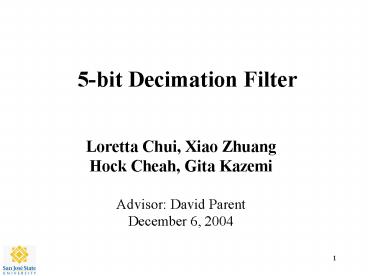5-bit Decimation Filter PowerPoint PPT Presentation
1 / 22
Title: 5-bit Decimation Filter
1
5-bit Decimation Filter
- Loretta Chui, Xiao Zhuang
- Hock Cheah, Gita Kazemi
- Advisor David Parent
- December 6, 2004
2
Agenda
- Abstract
- Introduction
- Project Details
- Results
- Cost Analysis
- Conclusions
3
Abstract
- We designed a 5-bit Decimation Filter, which can
be used to sample the output of an A/D converter
at a lower rate. Our system operates at 143 MHz,
uses less than 100 mW of power, and occupies an
area of 360 x 280 mm2.
4
Introduction
- The averaging filter used at the output of an A/D
converter is called a decimation filter. - The decimation filter samples the incoming data
until the sum of k inputs has been accumulated.
Then, the sum is dumped into an output flip-flop.
Through this process, the filter reduces
(decimates) the output frequency by k times.
5
(No Transcript)
6
Longest Path Calculationsfor the 7-bit Adder
7
Longest Path Calculationsfor the D-Flipflops
8
Decimation Filter Schematic
9
System Counter
10
Decimation Filter Layout
11
LVS Verification
12
Simulations (schematic)
13
Simulations (extracted)
14
Impulse Input
Impulse Output
Step Output
Step Input
15
DFF Rise Time For Hold
DFF Fall Time For Hold
16
DFF Rise Time for Setup
DFF Fall Time for Setup
17
Power Waveform
18
Cost Analysis
- Estimated time spent on each phase of the
project - verifying logic (1 week)
- verifying timing (1 week)
- layout (3 weeks)
- post extracted timing (1.5 weeks)
19
Conclusion
- We designed a decimation filter, which samples
and sums the incoming data 3 inputs at a time.
Through this process, the filter reduces
(decimates) the output frequency by a factor of
3. - Our design met all specifications except for
timing because our adder was too slow. - We propose the use of an alternative design,
which uses a mux select to implement a faster
adder.
20
Alternative Adder using a Mux Select
21
Lessons Learned
- It would be helpful to students to use a layered
approach for the chip layout by creating
instances of individual parts instead of copy and
paste to improve debugging capabilities. - It would be helpful if professors could spend
some time to cover testing methodology.
22
Acknowledgements
- Thanks to our family and friends who missed us
for the past 3 months. - Thanks to Cadence Design Systems for the VLSI
lab. - Thanks to Dr. Parent and John for their advice
and great patience.

